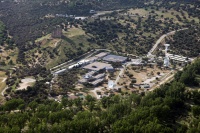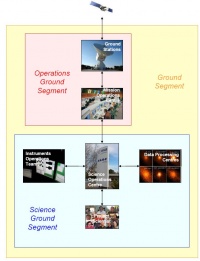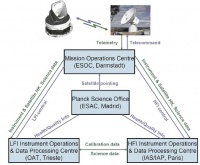Difference between revisions of "Ground Segment and Operations"
(→The data flow in the Planck Ground Segment) |
|||
| (9 intermediate revisions by 2 users not shown) | |||
| Line 1: | Line 1: | ||
== Geographical distribution of the Planck Ground Segment== | == Geographical distribution of the Planck Ground Segment== | ||
| − | The Planck Ground Segment | + | The Planck Ground Segment consists of four geographically distributed centres: |
=== The Mission Operations Centre === | === The Mission Operations Centre === | ||
| Line 26: | Line 26: | ||
[[file:ESAC_6.JPG|thumb|200px|The European Space Astronomy Centre in Villanueva de la Cañada, Madrid, Spain, see of the Planck Science Office.]] | [[file:ESAC_6.JPG|thumb|200px|The European Space Astronomy Centre in Villanueva de la Cañada, Madrid, Spain, see of the Planck Science Office.]] | ||
| − | The Planck Science Office (PSO)is located at ESA’s European Space Astronomy Centre in Villanueva de la Cañada surroundings (Madrid, Spain). | + | The Planck Science Office (PSO) is located at ESA’s European Space Astronomy Centre in Villanueva de la Cañada surroundings (Madrid, Spain). |
Its main responsibilities include: | Its main responsibilities include: | ||
| − | * | + | * Coordinating scientific operations of the Planck instruments; |
| − | * | + | * Designing, planning and executing the Planck observation strategy; |
| − | + | * Providing MOC with a detailed pointing plan with a periodicity of about one month; | |
| − | * | + | * Creating and updating the specifications of the Planck Legacy Archive developed by the Science Archives Team at ESAC; |
| − | * | + | * Testing and operating the PLA. |
=== The LFI instrument operations and data-processing centre === | === The LFI instrument operations and data-processing centre === | ||
The LFI instrument operations and data processing centre, | The LFI instrument operations and data processing centre, | ||
| − | located at the Osservatorio Astronomico di Trieste (Italy), is | + | located at the Osservatorio Astronomico di Trieste (Italy), is responsible for the operation of the LFI instrument, and the processing of the data acquired by LFI into the final scientific products of the mission. |
| − | responsible for | ||
| − | |||
| − | |||
| − | |||
| − | |||
=== The HFI instrument operations and data-processing centre === | === The HFI instrument operations and data-processing centre === | ||
| Line 53: | Line 48: | ||
located respectively at the Institut d’Astrophysique Spatiale | located respectively at the Institut d’Astrophysique Spatiale | ||
in Orsay (France) and at the Institut d’Astrophysique de Paris | in Orsay (France) and at the Institut d’Astrophysique de Paris | ||
| − | (France), are similarly responsible for the | + | (France), are similarly responsible for the operation of the HFI instrument, and (with several other institutes in |
| − | of the HFI instrument, and (with several other institutes in | ||
France and the UK) for the processing of the data acquired | France and the UK) for the processing of the data acquired | ||
by HFI into the final scientific products of the mission. | by HFI into the final scientific products of the mission. | ||
| Line 60: | Line 54: | ||
== The data flow in the Planck Ground Segment == | == The data flow in the Planck Ground Segment == | ||
| − | The | + | The PSO sends the Pre-Programmed Pointing Lists (PPL) to the MOC. The Flight Dynamics team at ESOC adapts them into Augmented Pre-Programmed Pointing Lists (APPL) taking into account ground station scheduling, Operational Day (OD) boundaries and other issues. |
| − | The Flight Dynamics team at ESOC adapts them into Augmented Pre-Programmed Pointing Lists (APPL) taking into account ground station scheduling, Operational Day (OD) boundaries and other issues. | ||
[[file:GS.jpg|thumb|200px|General schematics of European Space Agency Science Ground Segments. This picture exhibits the way ESA Ground Segments are generally organized.]] | [[file:GS.jpg|thumb|200px|General schematics of European Space Agency Science Ground Segments. This picture exhibits the way ESA Ground Segments are generally organized.]] | ||
| Line 71: | Line 64: | ||
Science data is then transferred to both Data Processing Centres (DPC) which process the data and send quality reports to PSO. | Science data is then transferred to both Data Processing Centres (DPC) which process the data and send quality reports to PSO. | ||
| − | Science products (timelines, maps, etc) are exchanged between DPCs in order to | + | Science products (timelines, maps, etc) are regularly exchanged between DPCs in order to assist with calibration, systematics, and scientific issues. |
| − | |||
| − | == References == | + | More information about the Planck Ground Segment may be found in {{PlanckPapers|tauber2010a}}. |
| − | + | ==References== | |
| + | <references /> | ||
| − | [[Category: | + | [[Category:Introduction|003]] |
[[Category:PSOBook]] | [[Category:PSOBook]] | ||
Latest revision as of 14:24, 22 July 2014
Contents
Geographical distribution of the Planck Ground Segment[edit]
The Planck Ground Segment consists of four geographically distributed centres:
The Mission Operations Centre[edit]
The mission operations centre (MOC), located at ESA’s operations centre in Darmstadt (Germany), is responsible for all aspects of flight control and of the health and safety of the Planck satellite, including both instruments. It plans and executes all necessary satellite activities, including instrument commanding requests by the instrument operations centres.
MOC communicates with the satellite using ESA’s 35-m antenna located in New Norcia (Australia), or that in Cebreros (Spain), over a daily 3-h period, during which it uplinks a scheduled activity timeline which is autonomously executed by the satellite, and downlinks the science and housekeeping (HK) data acquired by the satellite during the past 24 h. The downlinked data are transferred from the antenna to the MOC over a period of typically 8 h; at MOC they are put onto a data server from where they are retrieved by the two Data Processing Centres.
The Planck Science Office[edit]
The Planck Science Office (PSO) is located at ESA’s European Space Astronomy Centre in Villanueva de la Cañada surroundings (Madrid, Spain).
Its main responsibilities include:
- Coordinating scientific operations of the Planck instruments;
- Designing, planning and executing the Planck observation strategy;
- Providing MOC with a detailed pointing plan with a periodicity of about one month;
- Creating and updating the specifications of the Planck Legacy Archive developed by the Science Archives Team at ESAC;
- Testing and operating the PLA.
The LFI instrument operations and data-processing centre[edit]
The LFI instrument operations and data processing centre, located at the Osservatorio Astronomico di Trieste (Italy), is responsible for the operation of the LFI instrument, and the processing of the data acquired by LFI into the final scientific products of the mission.
The HFI instrument operations and data-processing centre[edit]
The HFI instrument operations and data processing centres, located respectively at the Institut d’Astrophysique Spatiale in Orsay (France) and at the Institut d’Astrophysique de Paris (France), are similarly responsible for the operation of the HFI instrument, and (with several other institutes in France and the UK) for the processing of the data acquired by HFI into the final scientific products of the mission.
The data flow in the Planck Ground Segment[edit]
The PSO sends the Pre-Programmed Pointing Lists (PPL) to the MOC. The Flight Dynamics team at ESOC adapts them into Augmented Pre-Programmed Pointing Lists (APPL) taking into account ground station scheduling, Operational Day (OD) boundaries and other issues.
MOC sends pointing and instrument commands to the spacecraft, and receives the house-keeping telemetry and science data through the ground stations (for Planck, mostly the New Norcia and Cebreros ones).
Science data is then transferred to both Data Processing Centres (DPC) which process the data and send quality reports to PSO.
Science products (timelines, maps, etc) are regularly exchanged between DPCs in order to assist with calibration, systematics, and scientific issues.
More information about the Planck Ground Segment may be found in Planck-PreLaunch-XI[1].
References[edit]
- ↑ Planck pre-launch status: The Planck mission, J. A. Tauber, N. Mandolesi, J.-L. Puget, T. Banos, M. Bersanelli, F. R. Bouchet, R. C. Butler, J. Charra, G. Crone, J. Dodsworth, et al., A&A, 520, A1+, (2010).
[ESA's] Mission Operation Center [Darmstadt, Germany]
European Space Agency
House Keeping
Planck Science Office
Planck Legacy Archive
(Planck) Low Frequency Instrument
(Planck) High Frequency Instrument
Pre-programmed Pointing List
European Space Operations Centre (Darmstadt)
Augmented Preprogrammed Pointing List
Operation Day definition is geometric visibility driven as it runs from the start of a DTCP (satellite Acquisition Of Signal) to the start of the next DTCP. Given the different ground stations and spacecraft will takes which station for how long, the OD duration varies but it is basically once a day.
Data Processing Center
[LFI meaning]: absolute calibration refers to the 0th order calibration for each channel, 1 single number, while the relative calibration refers to the component of the calibration that varies pointing period by pointing period.



